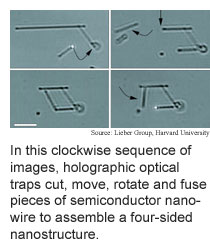
Week
of November 7, 2005
Holograms
organize nanowires
During the past few years scientists have gotten good at using
holograms to move and manipulate microscopic objects. The methods, however,
are usually limited to spherical objects, which include cells and microbes.
 Researchers from Harvard University and New York University have
found
a way to use holographic optical traps to move and manipulate long,
thin semiconductor nanowires. Holographic optical traps are computer-controlled
holograms focused through a microscope onto objects floating in liquid.
Researchers from Harvard University and New York University have
found
a way to use holographic optical traps to move and manipulate long,
thin semiconductor nanowires. Holographic optical traps are computer-controlled
holograms focused through a microscope onto objects floating in liquid.
The method can be used to move, rotate, cut and fuse semiconductor
nanowires. The researchers demonstrated the technique by constructing
a rhombus from cadmium sulfide nanowires.
The work is a step toward a key ability: being able to assemble
many complex, three-dimensional nanowire structures at once. This would
enable the manufacturing of new forms of optical and electronic devices
like fast, high-capacity computer memory chips.
(Manipulation and Assembly of Nanowires with Holographic Optical
Traps, Optics Express, October 31, 2005)
DNA delivers anti-cancer drug
Nanotechnologies that tap DNA have heated up lately, especially
in the drug delivery field.
Researchers from Harvard University and the Massachusetts Institute
of Technology have reported the latest in a string of nanotech advances
to fight cancer. The anti-cancer therapy combines
polymer nanoparticles that contain an anti-cancer drug with short strands
of DNA or RNA that bind to a protein found on the outside of prostate
cancer cells.
The polymer is biocompatible and breaks down over a controllable
amount of time to release the drug. The researchers tested the nanoparticle-DNA
treatment on prostate cancer cells inside a microfluidic device designed
to mimic conditions inside the body. They found that the anti-cancer drug
was taken in by the cancer cells but not by surrounding healthy cells.
Other scientists have recently made RNA
nanoparticles that deliver anti-cancer drugs to cancer cells, DNA-polystyrene
spheres that could be used for drug delivery, and polymer
nanoparticles that contain an anti-cancer drug and folic acid, which
is readily absorbed by cancer cells.
(Cancer Nanotechnology: Drug Encapsulated Nanoparticle-Aptamer
Bioconjugates for Targeted Delivery to Prostate Cancer Cells, 13th European
Cancer Conference (ECCO), Paris, October 30-November 3, 2005)
Tiny sensors tracked
The continuing miniaturization of electronic devices has reached
a point where tiny, inexpensive sensors scattered throughout an environment
are becoming practical. Networks of sensors could be used to monitor aspects
of the environment, collect data for scientific research and track troop
and vehicle movements for military applications.
Finding ways for the diminutive devices to locate and communicate
with each other efficiently is a particularly active area of study.
Researchers from Vanderbilt University have come
up with a way to determine individual sensors' positions using the
radiowaves sensors use to communicate with each other.
The method measures radio signal interference across several sensors
in a network to determine the strength of a given sensors' signal. The
method works in networks of as few as six sensors.
The researchers' prototype located sensors to within three centimeters
at ranges of up to 160 meters.
(Radio Interferometric Positioning, 3rd ACM Conference on Embedded
Networked Sensor Systems (SenSys), San Diego, November 2-4, 2005)
Sensors net tree data
Scientists are beginning to use networks of tiny sensors to collect
data that would be impractical to gather using traditional methods.
Researchers from the University of California at Berkeley and
Intel Research have deployed
a sensor network around a 70-meter tall redwood tree to study the
microclimate around the tree and evaluate real-world use of sensor networks.
The one-inch-diameter sensors took readings of temperature, humidity,
barometric pressure, direct sunlight and ambient light every five minutes.
Thirty-three sensors were deposited on the tree at 2-meter intervals.
The "macroscope" experiment ran for 44 days, and yielded 820,700 pieces
of information, which was 49 percent of the data points the network was
set to try to measure.
The study yielded information about the spatial and temporal variations
in the microclimate around the tree. It also brought to light some ongoing
technical challenges: positioning the sensors, monitoring their status
and analyzing large amounts of data.
(A Macroscope in the Redwoods, 3rd ACM Conference on Embedded
Networked Sensor Systems (SenSys), San Diego, November 2-4, 2005)
Bits and pieces
A software system uses Web documents to sort
out people who have the same common names; neural network software
uses video images of reefs to automatically
classify live coral, dead coral and non-coral areas; interferometric
measurements provide a detailed view
of slow light traveling through silicon photonic crystals.
RSS Feeds: News Blog Books New: TRN's Internet Services TRN's Jobs Center News: Research News Roundup Research Watch blog Features: View from the High Ground Q&A How It Works Buy an ad link |
|
| Advertisements: |
|
Ad links: Clear History
Buy an ad link
|
TRN
Newswire and Headline Feeds for Web sites
|